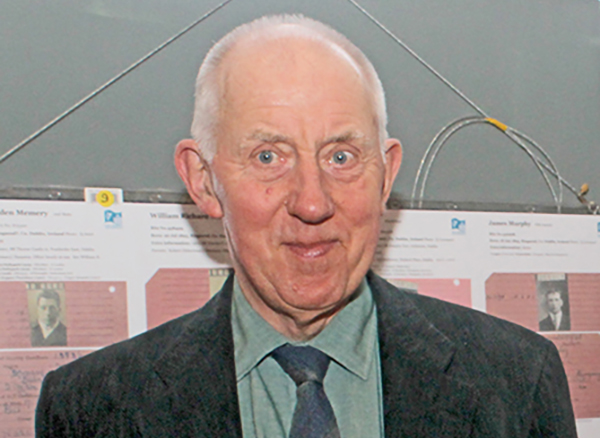
David Snook, organiser of the exhibition.
Ringsend’s traditional links with the sea were brought to life recently with the opening of an exhibition in Pearse Street Library of 70 Ringsend men who served in the Merchant Navy from 1918–1921. It was kindly organised by David Snook of the Irish Mariners Association, who has organised similar exhibitions highlighting the seamen of different Irish coastal villages who served abroad.
Snook’s involvement in the project began when he wanted to investigate a family story that existed about his grandfather, who served on a torpedoed Royal Navy ship called HMS Goliath.
Snook checked the National Archives in Kew, London, and found that of the many who died, about 40–50 were Irish. One of them was from Rush, Co. Dublin, where he now lives. This peaked Snook’s interest to continue on a mission to find out more about Irishmen who served abroad, leading in particular to the Merchant Navy, and he has visited Southampton Civic Archives on at least 20 occasions, many times bringing family members along to help him.
Snook has discovered 23,000 Irish-born merchant seamen and their voyages within 300,000 records held at Southampton Civic Archives. These index cards hold valuable information covering the British Merchant Marine from early September 1918, the closing two months of World War One, until December 1921. One valuable element of these 300,000 cards is that they usually contain a good passport-style photograph of the seaman. They also contain personal details as well as voyage records.
Families interested in finding out about their forefathers’ adventures discovered an amazing story when they visited the exhibition, which was on show throughout August. Attending the opening of the exhibition were descendants of Ringsend seamen hoping to make such discoveries.
One such attendee was Susan Barr, whose grandfather John Blackmore had his details displayed along with four nephews: William, Samuel, Richard, and James. John Blackmore served on many ships and lost his life, along with all onboard the torpedoed James Seckar out in the Atlantic Ocean in 1917. John Blackmore’s son Samuel was a brave volunteer on Dun Laoghaire lifeboats who saved many lives on the Bolivar, the Norwegian ship that ran aground on the Kish Bank in 1947.
Another lady, Breda Mulligan, who now lives in Clondalkin, had a connection to Joseph Talbot, who was a descendent of her great, great, great grandfather.
Snook noted that exhibitions are great for discovering more information from locals about the records that he holds. A great example regards an update about brothers Edmund and John Crabbe, who were both on exhibition. Jenny Cangley states that, “Edmund and John were my uncles.
Their father, John Crabbe, was my grandfather. Eddie died in 1922 in Erris, Co. Mayo, fighting on Michael Collins’s side in the Civil War. He was a sergeant major, quite a young age to be that. He is buried in the plot with Michael Collins and I believe he helped carry the coffin of Michael Collins.”

A selection of CR10 cards used to indentify sailors.
The names of the men on exhibition at Pearse Street library included Adams, Adderly, Byrne, Brady, Bissett, Blackmore, Crabbe, Dalton, Duncan, Edwards, Elliott, Gavan, Hawkins, Hopkins, Lawless, Lacey, Knott, Maher, McDonnell, Memery, Mooney, Murphy, Murray, O’Reilly, O’Shea, Paget, Purcell, Pullin, Purdy, Quinn, Rowden, and Sullivan.
David is planning more exhibitions around other coastal villages in the near future.
More information, and all the 23,000 records, can be found on www.irishmariners.ie
By Ferg Hayden

